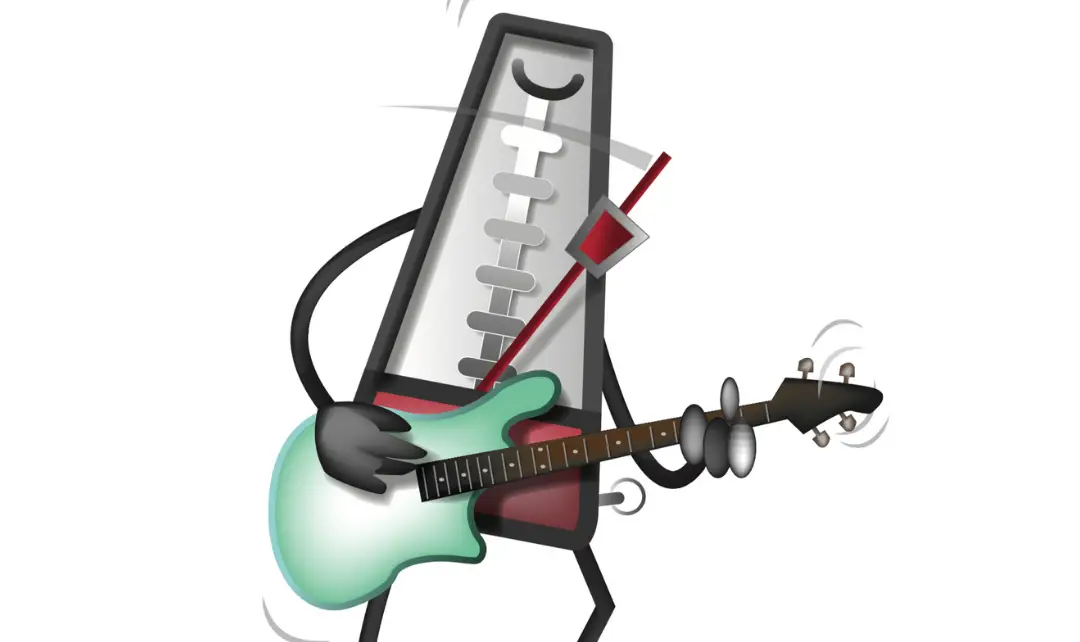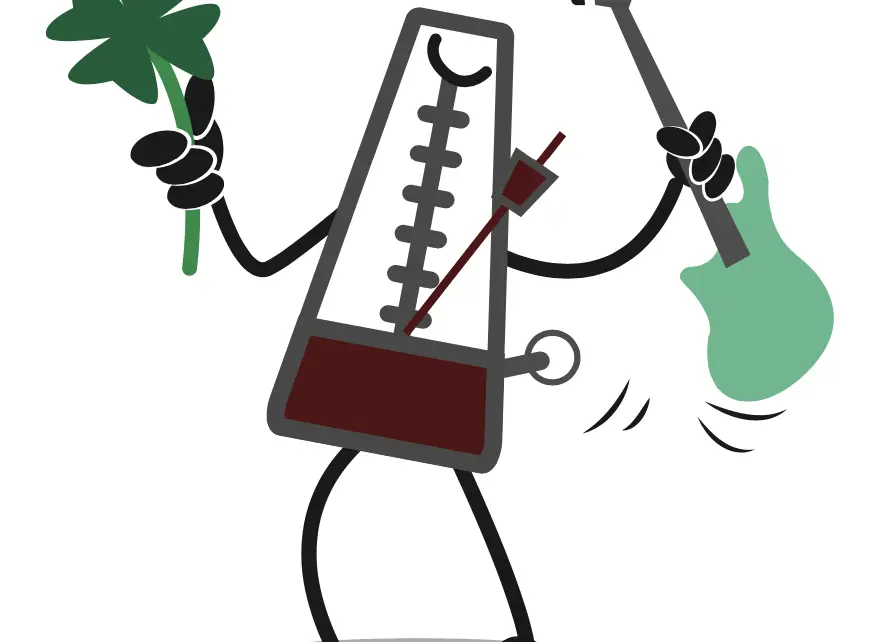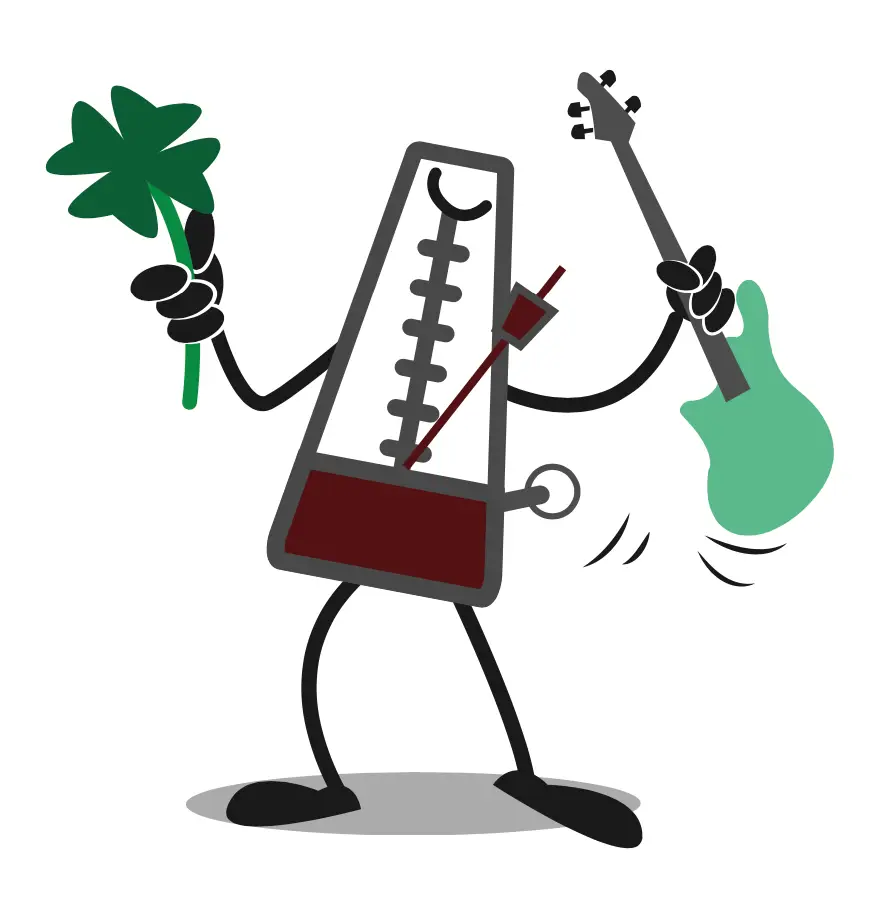Skippy MacBeat
 Whether you call him the “metrognome” (Steve Bailey), the “basscot” (Forrest from our Facebook group), channeling Pete Townsend as “Skippy MacPete”, or by his real name Skippy MacBeat, this lovable little vintage metronome is the star of my new book – The Pattern System for the Bass Player – Sharpen your Musical Mind Through Fretboard Proficiency, Improvisation, and Mental Practice written with Wolf Wein.
Whether you call him the “metrognome” (Steve Bailey), the “basscot” (Forrest from our Facebook group), channeling Pete Townsend as “Skippy MacPete”, or by his real name Skippy MacBeat, this lovable little vintage metronome is the star of my new book – The Pattern System for the Bass Player – Sharpen your Musical Mind Through Fretboard Proficiency, Improvisation, and Mental Practice written with Wolf Wein.
He has a bit of an attitude but a lot of wisdom and he will be your sidekick on the epic journey through our Pattern System.
He may just seem like a cute addition at first glance, or even like a distraction or diminishing the academic quality of this book; nothing could be further from the truth, however.
Yes, he contributes a lighter side to a rigorous program, but that is far from all he contributes! Please reserve judgment until you see him in action – there is a lot more to this little cartoon character than meets the eye…
Here is a bit of his story
When diving into the Pattern System you get precise instructions when and how to use the metronome. I wanted the instructions to catch the reader’s eye because one of the main achievements of this method is learning to think ahead in time of the music. For this reason, the use of the metronome is not optional with this method. To underscore that fact, I gave him a personality.
The use of the metronome is vastly misunderstood by many online. While sometimes not using a click can indeed be the right decision, to make blanket statements such as “the use of the metronome is never warranted”, “not musical” or even “detrimental” leads to confusion at best and lost practicing opportunities at worst. There is a lot more to it.
Using the Click for Timing
The metronome has long established itself as a great practice tool for timing and grooving. such as:
- playing with a drummer
- preparing for playing to a click in headphones in the studio or at a show
- more precise situations for practicing timing, from precision to subdivision
- developing excellent internal timing (independent from an external click)
Many sophisticated and creative ways of practicing with a click exist – for instance:
- skipping random beats
- placing the click on unexpected beats
- or using one downbeat click only every second, fourth, eighth bar…
- here is a great video for example (Victor Wooten demonstrating metronome use for practicing good timing)
 The Lack of Musical “Feel”
The Lack of Musical “Feel”
Sometimes Skippy gets vilified for not having a musical feel like a human does.
I’ll tell you a secret: “feel” for musical reasons can only bloom if you know that your “feel” does not stem from other reasons such as unconscious hesitations because of technical issues or not knowing the piece well enough. That’s not feel, that is an excuse. So, start with the correct beat, then (and only then) expand to feel.
Similarly, some rhythm sections are famous for one or more members playing slightly ahead of or behind the beat. Soloists and vocalists often like to lay back.
Again, even when the goal is to play freely around the beat or freely with the beat, my first advice is to play with a click to make sure that the free playing is motivated by musical reasons rather than by inaccuracies or technical deficiencies that are then disguised as “playing freely”. Furthermore, if the vocalist or soloist is laying back on the beat, it is critical that you double-down on staying right on the beat, otherwise you’ve defeated their musical intent and essentially just slowed down the song.
I’ll go as far as to say unless you can play well with the beat you have no business attempting creative freedom. It is too easy to mask a technical deficiency by fudging it and calling it “artistic freedom”.
The Click as an Invaluable Practice Tool in the Pattern System
When acquiring musical skill, we have to learn to multitask on a very high level – moving fingers, keeping track, listening to others and ourselves, creating, supporting or taking the lead, responding, etc… It’s a lot and the Pattern System offers systematic ways to achieve this skill. The correct use of the metronome with the right exercises can help you get better with all of this.
In the new book, the click has a very important function helping you:
- to think ahead
- really hear what you are playing rather than what you think you are playing
- to practice multitasking of the kind we do in music all the time!
We do all this with specific drills on and off (mental practice) the instrument.
The power of the metronome as a practice tool is right up there with recording yourself (which is what we do in our Cohort Courses and yields excellent results).
How to use the Metronome Correctly
Thinking ahead in time with the music is a vastly under-appreciated skill, but an incredibly important one. Learning to think ahead enables you to truly “think music”. Your mindset changes from “chasing the notes” to leading and creating! Sound good?
Attaining this skill changes everything in your playing!
It assures that you are not just poking around hoping to hit the intended notes, but know exactly what notes are next and provides a clear, relaxed path to them.
- We go into detail about thinking musical processes and why the click is so crucial along that journey.
- We talk about when exactly to use the metronome and when to skip it and why.
- How to ease yourself into the use of it when it seems you are not quite ready (I call this the concept of “Cheater Beats”).
- How to set the best tempo.
I can tell you all about how great and useful the metronome is in theory, but if you actually do the exercises a few times as described in the book, it will “click” on a much deeper level!

Skippy holds a mirror up to you
In the book, I go into detail as to what constitutes incomplete knowledge. Unconscious thinking pauses, for example, can be detrimental – like what happens at home when practicing and you take an extra “moment” to think about the next note or a phrase. In the studio or on stage we do not have that luxury. And without Skippy keeping us honest and providing valuable feedback as to where the downbeat really is, we may never have realized it.
 Skippy is the Perfect Practice Coach
Skippy is the Perfect Practice Coach
Skippy gets some of the most important lines in the book. They are sometimes words, and at other times drawings that illustrate
-
-
-
-
- practicing attitude
- how to be your own coach
- and how to practice effectively
-
-
-
Pictures are worth a thousand words and learning psychology has proven that images and metaphors help us ingrain material.
Humor
Skippy does provide a bit of humor when he channels a few wise people or when he is just a bit of a brat. We thought on an epic journey such as this, a little sidekick would be just the right help along the way!
An excerpt from the book
Here are three pages from the book where I give Skippy a proper introduction.
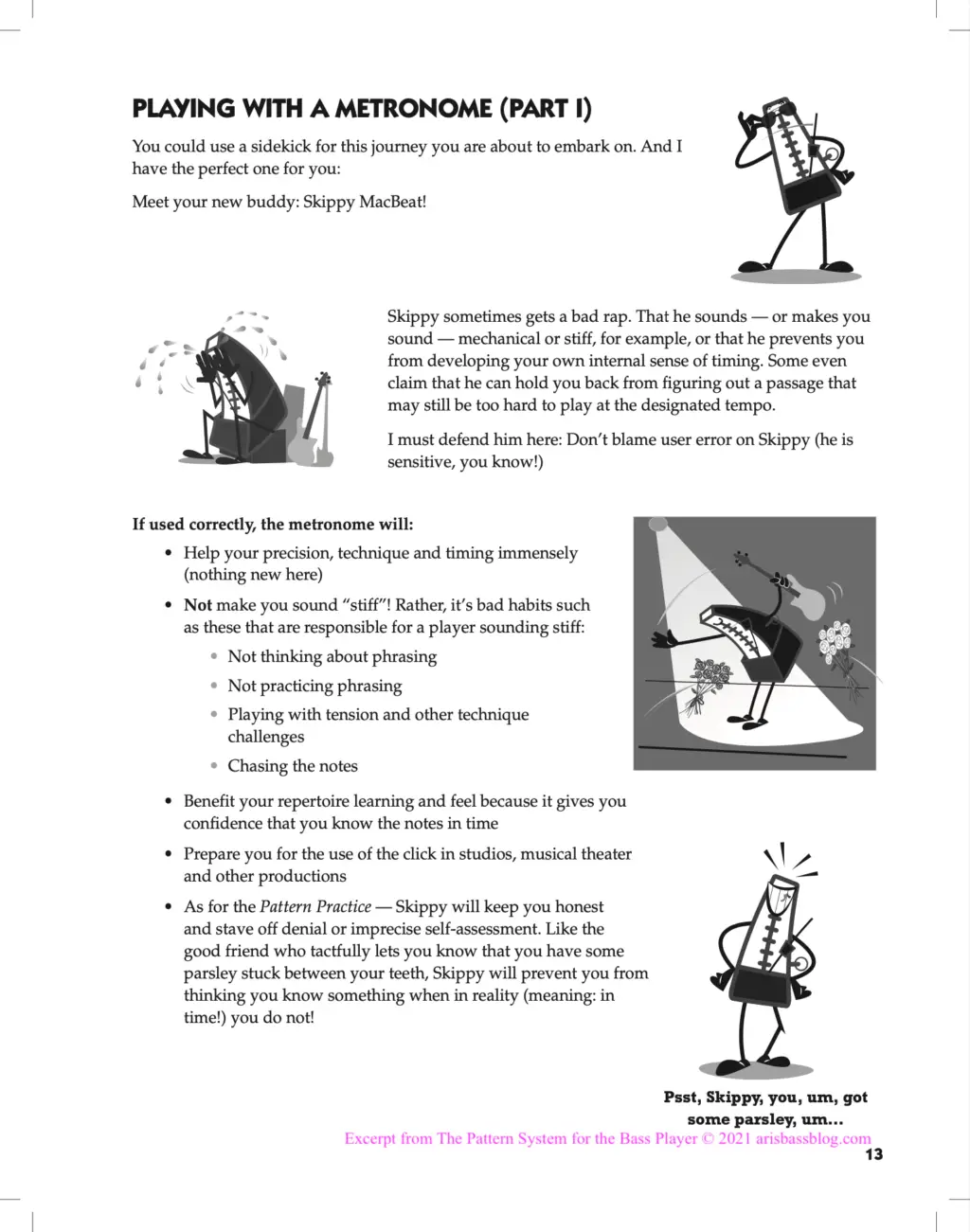

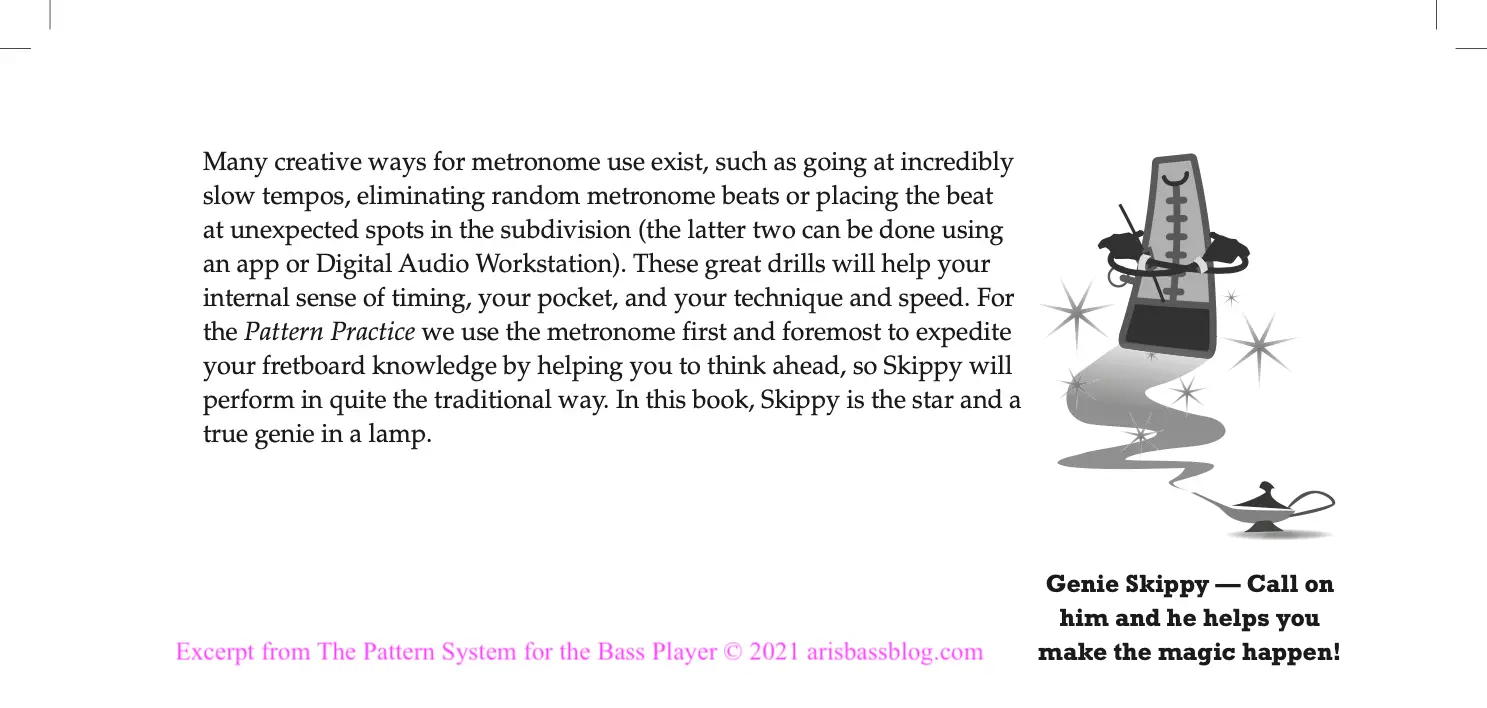
Throughout the book, you will learn how to use the metronome in order to maximize your success with music. The question is not just when to use it and at what tempo, but what to think (or even say) while using it. I know this works and this effort is very well worth it. Why? Because I have helped hundreds of students get through the typical stumbling blocks of not being able to create their own grooves or take tunes down from recordings, and helped them get to know the fretboard so well that they can play freely. When learning to read, this knowledge gives you a huge leg up as well. Always practice with a beat in order to make sure you don’t insert tiny unconscious thinking pauses.
Everything in music happens to a beat and on a timeline – be it grooving, improvising, thinking ahead, recreating something, or creating something from scratch. Remember: If it doesn’t happen “in time” while grooving, it doesn’t happen!
We show you powerful drills in this program that lead to predictable and consistent progress.
No ifs, ands or buts- non-negotiable, I say! If you are looking to transform your playing, follow along and don’t skip a beat!
May 2nd is the last day for you to participate in our Indiegogo campaign and take advantage of amazing pre-order deals and perks.
Editor’s Note: We have less than 100 Pattern System books (spiral bound) available at this special pricing. Once they are gone… they are gone – at this special price and – (at least for a while) with this binding, so don’t miss out! Find out more and order your copy here.

